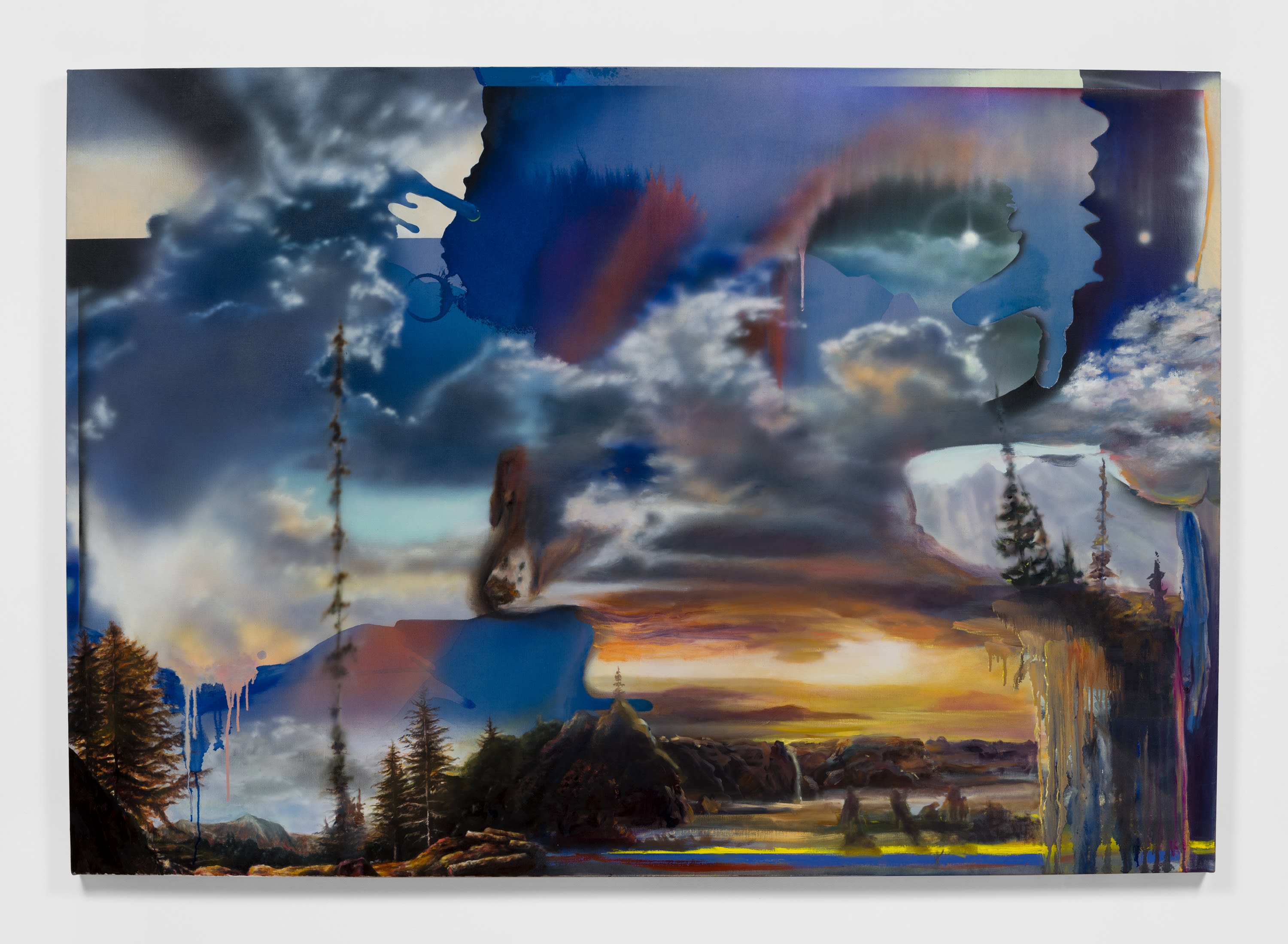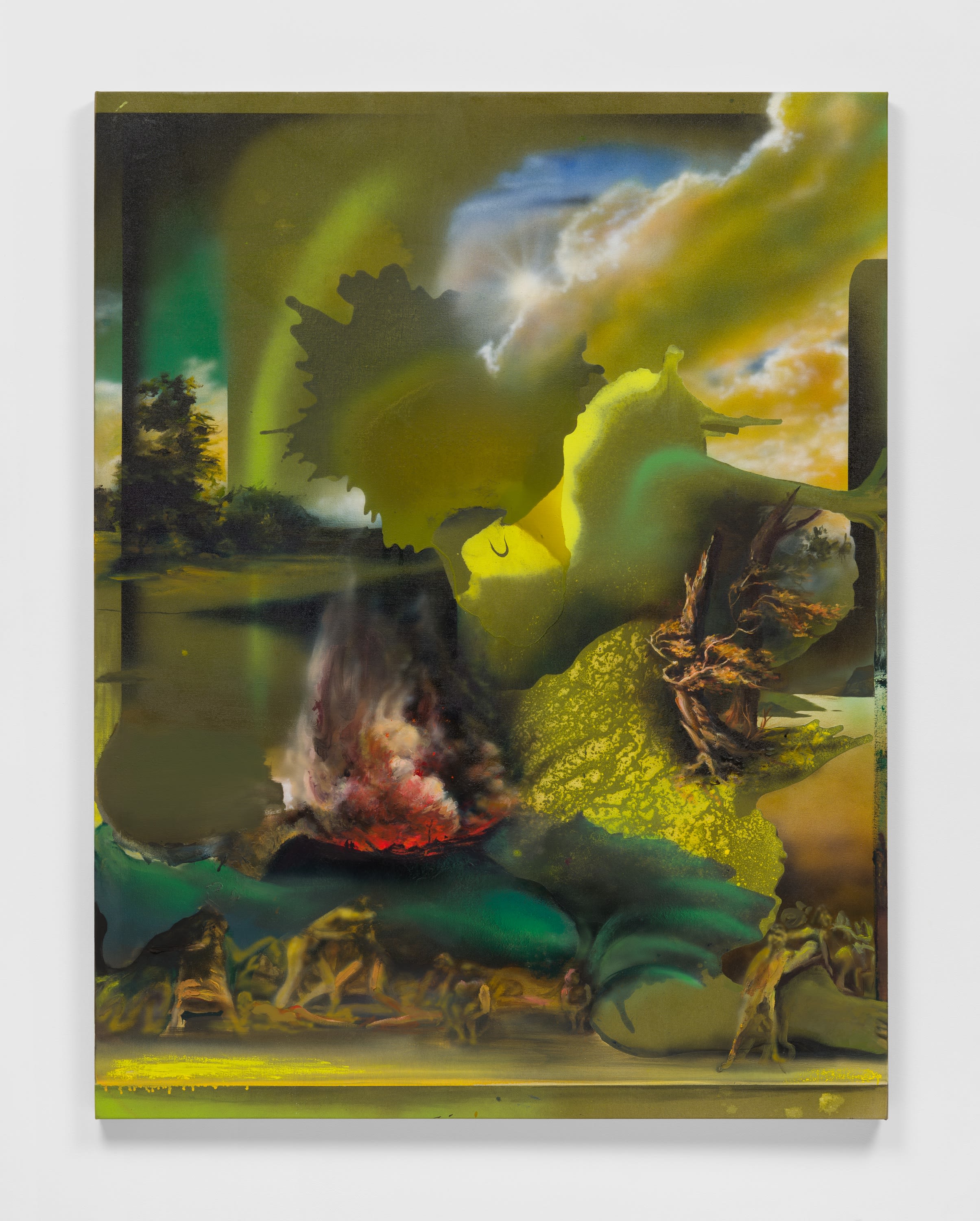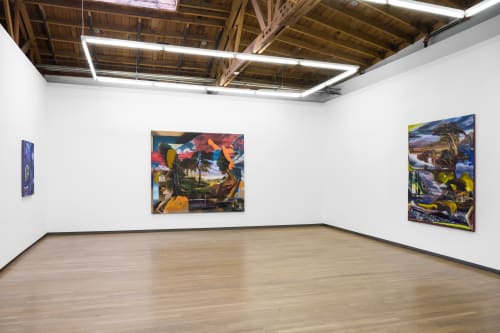
Using a visual vocabulary steeped in art historical tropes, Annie Lapin’s new paintings nevertheless present a novel vision of how consciousness might work, that is, of the way our thoughts, memories, and observations inhabit and interact within the hard drives of our minds. With incongruous juxtapositions and everything in seeming flux, these paintings share an affinity with the 1940s “psychological morphologies” of Surrealist Roberto Matta Echaurren (1911-2002). Unlike Matta, who was interested in visualizing what happens in the liminal zones of the collective unconscious, Lapin’s imagery is about the entire space/time continuum and includes more references to the physical world than to any imagined universes.

ANNIE LAPIN, “LIGHT LEAK,” 2022, ACRYLIC, OIL PAINT AND OIL STICK ON PVAED LINEN, 54 1/2 X 78 1/4” ALL IMAGES COURTESY OF THE ARTIST AND SHULAMIT NAZARIAN, LOS ANGELES. ALL PHOTOS: ED MUMFORD.
On the surface, Lapin’s paintings look like trompe-l’oeil versions of the “paste-up” collages by the Bay Area Beat artist Jess (1923-2004), who built densely complex compositions by joining together irregularly shaped fragments composed of clippings cut from magazines, posters, prints, and books. In Lapin’s case, the imagery is all paint, with each work originating from abstract marks formed by pouring generous amounts of acrylic and liquid graphite across a canvas’s surface and then developing them into abstract shapes or recognizable subjects, all of which are allowed to coexist within a single work. Although the compositions are punctuated with partially visible human or animal bodies as well as abstract shapes and fluid streams, the dominant elements refer to landscape. Lapin conceives of her topography as “a hall of mirrors, reflections of reflections of our past, stories about the world, and stories about ourselves intermingled with geological events.”
 ANNIE LAPIN,”POSE (STATES OF WATER),” 2022, ACRYLIC, OIL AND OIL STICK ON LINEN, 72 X 59”
ANNIE LAPIN,”POSE (STATES OF WATER),” 2022, ACRYLIC, OIL AND OIL STICK ON LINEN, 72 X 59”
For the viewer, the challenge is in extracting meaning, finding order within the chaos of Lapin’s invented universes. While this may be a good way to sharpen our visual thinking skills, some of the larger works transcend intellect with imagery that triggers emotional responses. “Light Folding,” for example, is filled with several moments of high drama. At the core of the composition (although slightly off center), a clockwise rotational movement emerges from the juxtaposition and interaction of several representations of the forces of nature: a raging fire, a placid lake, an abstract splash with a hint of a rainbow, billowing clouds, a windblown tree, and another abstract passage that resembles microscopic matter. Below all this, an oversized human leg and foot are strewn atop a simulated ledge along with clusters of people engaged in battle, like Gulliver’s limb among disgruntled Lilliputians. As a counterpoint to the suggestion of violence, which these days seems to be a constant in the ordinary world, a more spiritual tone is struck in the composition’s upper regions, where a luminous sun in a clear blue sky shines eternally in the distance.

ANNIE LAPIN,”LIGHT FOLDING,” 2022, ACRYLIC AND OIL STICK ON LINEN, 57 X 44”
Although Lapin never refers to spirituality in her artist’s statement, she acknowledges the influence of “the sublime imagery of Western landscape and photography,” and thus paints the sun as if it has divine powers, an approach that she shares with Los Angeles contemporaries such as Kelly Berg and Sharon Ellis, both of whom equate the sun with a healing energy. The implied narrative here moves upwards from the earthbound to the celestial in a manner that recalls Caspar David Friedrich’s symbolic depictions of the life cycle. Lapin’s metaphoric journeys through a lifetime are filled with many more twists, turns, and interruptions than is seen in Friedrich’s 19th century straight-line sequencing, and also consider currently relevant matters such as climate change.

ANNIE LAPIN, “VEIL AND SEERS,” 2022, ACRYLIC, OIL AND OIL STICK ON LINEN, 82 X 96”.
Two other particularly stirring paintings here are “Pose (States of Water)” and “Veil and Seers.” In the former, Lapin organizes gloomy landscapes with overcast skies into four registers that are unified by the downward movements of depicted water and literal paint drips, all of which leads the eye to the bottom of the composition, where leg and foot motifs once again appear. This time the body parts are trapped beneath a fallen tree trunk, a device that reminds us of the environmental decay and destruction that continue to plague the planet. By contrast, “Veil and Seers” is actually quite hopeful and inspiring. With the painted clutter around the edges opening up to reveal an idealized landscape of blooming trees and beautiful weather, the image strongly suggests that, as we navigate the trials and tribulations of our existence, we should never abandon the search for paradise at the end of the tunnel.

